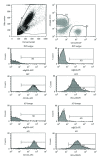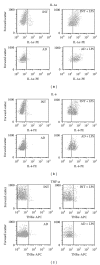Mild systemic oxidative stress in the subclinical stage of Alzheimer's disease
- PMID: 24454987
- PMCID: PMC3880752
- DOI: 10.1155/2013/609019
Mild systemic oxidative stress in the subclinical stage of Alzheimer's disease
Abstract
Alzheimer's disease (AD) is a late-onset, progressive degenerative disorder that affects mainly the judgment, emotional stability, and memory domains. AD is the outcome of a complex interaction among several factors which are not fully understood yet; nevertheless, it is clear that oxidative stress and inflammatory pathways are among these factors. 65 elderly subjects (42 cognitively intact and 23 with probable Alzheimer's disease) were selected for this study. We evaluated erythrocyte activities of superoxide dismutase, catalase, and glutathione peroxidase as well as plasma levels of total glutathione, α-tocopherol, β-carotene, lycopene, and coenzyme Q10. These antioxidant parameters were confronted with plasmatic levels of protein and lipid oxidation products. Additionally, we measured basal expression of monocyte HLA-DR and CD-11b, as well as monocyte production of cytokines IL1-α, IL-6, and TNF-α. AD patients presented lower plasmatic levels of α-tocopherol when compared to control ones and also higher basal monocyte HLA-DR expression associated with higher IL-1α production when stimulated by LPS. These findings support the inflammatory theory of AD and point out that this disease is associated with a higher basal activation of circulating monocytes that may be a result of α-tocopherol stock depletion.
Figures


Similar articles
-
Antioxidant defences and oxidative stress markers in erythrocytes and plasma from normally nourished elderly Alzheimer patients.Age Ageing. 2001 May;30(3):235-41. doi: 10.1093/ageing/30.3.235. Age Ageing. 2001. PMID: 11443025
-
Association between enzymatic and non-enzymatic antioxidant defense mechanism with apolipoprotein E genotypes in Alzheimer disease.Clin Biochem. 2008 Aug;41(12):932-6. doi: 10.1016/j.clinbiochem.2008.05.001. Epub 2008 May 15. Clin Biochem. 2008. PMID: 18505684
-
Plasma antioxidants are similarly depleted in mild cognitive impairment and in Alzheimer's disease.Neurobiol Aging. 2003 Nov;24(7):915-9. doi: 10.1016/s0197-4580(03)00031-9. Neurobiol Aging. 2003. PMID: 12928050 Clinical Trial.
-
Metals, oxidative stress and neurodegenerative disorders.Mol Cell Biochem. 2010 Dec;345(1-2):91-104. doi: 10.1007/s11010-010-0563-x. Epub 2010 Aug 22. Mol Cell Biochem. 2010. PMID: 20730621 Review.
-
Nutritional antioxidants and the heme oxygenase pathway of stress tolerance: novel targets for neuroprotection in Alzheimer's disease.Ital J Biochem. 2003 Dec;52(4):177-81. Ital J Biochem. 2003. PMID: 15141484 Review.
Cited by
-
Vitamin E and Alzheimer's disease: what do we know so far?Clin Interv Aging. 2019 Jul 18;14:1303-1317. doi: 10.2147/CIA.S186760. eCollection 2019. Clin Interv Aging. 2019. PMID: 31409980 Free PMC article. Review.
-
Neuroprotective mechanisms of astaxanthin: a potential therapeutic role in preserving cognitive function in age and neurodegeneration.Geroscience. 2017 Feb;39(1):19-32. doi: 10.1007/s11357-017-9958-x. Epub 2017 Feb 13. Geroscience. 2017. PMID: 28299644 Free PMC article. Review.
-
The Effectiveness of Vitamin E Treatment in Alzheimer's Disease.Int J Mol Sci. 2019 Feb 18;20(4):879. doi: 10.3390/ijms20040879. Int J Mol Sci. 2019. PMID: 30781638 Free PMC article. Review.
-
Rhein Ameliorates Cognitive Impairment in an APP/PS1 Transgenic Mouse Model of Alzheimer's Disease by Relieving Oxidative Stress through Activating the SIRT1/PGC-1α Pathway.Oxid Med Cell Longev. 2022 Mar 22;2022:2524832. doi: 10.1155/2022/2524832. eCollection 2022. Oxid Med Cell Longev. 2022. PMID: 35360200 Free PMC article.
-
Time-course and intensity-based classifications of oxidative stresses and their potential application in biomedical, comparative and environmental research.Redox Rep. 2016 Nov;21(6):262-70. doi: 10.1080/13510002.2015.1126940. Epub 2016 Feb 5. Redox Rep. 2016. PMID: 26828292 Free PMC article.
References
-
- Dickerson BC, Bakkour A, Salat DH, et al. The cortical signature of Alzheimer’s disease: regionally specific cortical thinning relates to symptom severity in very mild to mild AD dementia and is detectable in asymptomatic amyloid-positive individuals. Cerebral Cortex. 2009;19(3):497–510. - PMC - PubMed
-
- Finch CE, Morgan TE. Inflammatory processes of Alzheimer disease and aging. Proceedings of the Indian National Science Academy B. 2003;69:165–178.
-
- Rojo LE, Fernández JA, Maccioni AA, Jimenez JM, Maccioni RB. Neuroinflammation: implications for the pathogenesis and molecular diagnosis of Alzheimer’s disease. Archives of Medical Research. 2008;39(1):1–16. - PubMed
MeSH terms
Substances
LinkOut - more resources
Full Text Sources
Other Literature Sources
Medical
Research Materials
Miscellaneous

